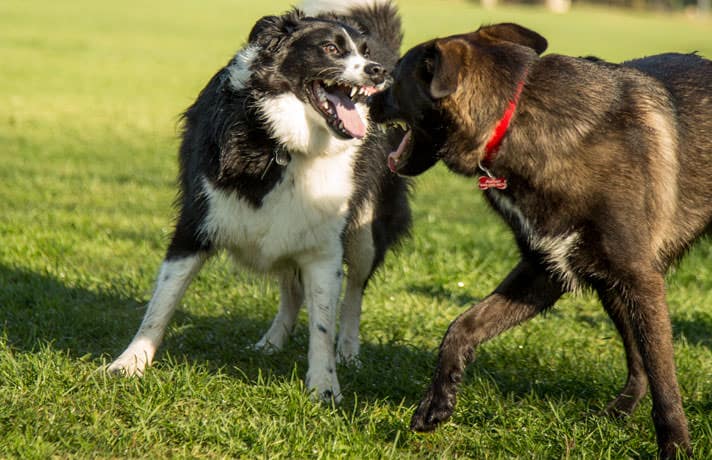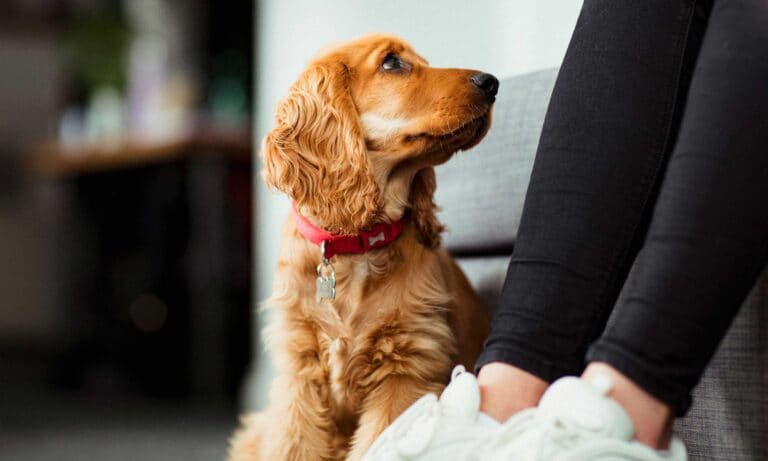So, you are at the dog park, at a friend’s for a puppy play date, or even at home in a multi-dog household, and the playing begins. Everything is going great at first, but as the play really gets going you notice growling, barking and even snarling — and you start to get nervous:
- Is this still play?
- Are the dogs getting upset?
- And the $64,000 question: Do I stop the play or separate the dogs?
Puppy Social Development
Before we take on those questions, let’s start with a little education on the developmental periods of dogs and how the age of the dogs can affect the play. Dogs have a very short “social development” period where they learn the rules of being social, how to play, and what is and is not appropriate behavior. It runs from about 3 weeks old to approximately 20 weeks old.
As puppies grow up in their litters they learn how to control their mouths (bite inhibition), and how rough play affects the manner in which their littermates react to and engage with them. If a puppy bites a littermate too hard during play, the bitten puppy will either not play with the pup, or correct the pup for his actions. Play teaches what is and what is not appropriate.
If you bring home a puppy who is 12 weeks old, that means you have approximately two months to continue this training and work on socialization, along with classical and operant conditioning. You might begin introducing your puppy to all sorts of new things and pairing him with positive experiences and food rewards. This teaches your puppy to enjoy life and not to fear new things. Keep in mind that dogs do not automatically know how to play or to even enjoy playing with other dogs — these are skills that must be taught. So, as you reach the end of the “social development” period, your puppy will be able to play safely with other dogs, right? Well, not quite (sorry).
After puppyhood comes the juvenile/adolescent stage. This begins at approximately 16 to 20 weeks of age and ends somewhere around 2 years of age. The exact age depends on the breed. This is the period of testing boundaries and finding out where the dog fits in the world. Trust me — testing Mom, Dad and other dogs he encounters will be a big part of his life and education during this time period.
6 Tips For Keeping Dog Play Safe
Now, you probably think at this point that all dogs are dangerous and that all play must be curtailed or supervised like a maximum security prison. Not true! I just want you to realize that the first couple of years in a dog’s life are very important; they teach all the skills to becoming a good social canine! So let’s look at some specific tips and tricks on how to keep playtime a positive experience.
1. Know the playmates: Dogs, like people, like things that are familiar. Playing with the same friends over a period of time is going to be the best bet for keeping things peaceful. Dogs who know each other know each other’s issues, likes and dislikes. Playtime among “close friends” will go smoother than if a dog is just tossed in with a strange dog he is unfamiliar with.
2. Take lots of little breaks: Overstimulation is one of the biggest issues causing normal play to become too rough or lead to arguments or fights. While this sounds way too simple, it really does work. Keep play sessions short and include lots of breaks to cut down on the rough play. It also helps teach the dogs that play that is too rough will end the play session. Taking lots of little breaks allows you to monitor and control their play style, and you end up with dogs who listen better and are more apt to calm down on command! These little breaks or “cool off” periods are short in duration, usually no more than 30 to 60 seconds. You then allow the play to continue.
3. Realize that arguments are normal: No one can say they have never been in an argument, so don’t expect it from your dog. I am willing to bet that at some point in your life you got upset — you might have even yelled at someone. As far as arguments go, dogs can be really noisy and it can sound really ugly. In most cases, the ugly noise is just an argument. I fall on the side of letting dogs work things out themselves for the most part, but, as with kids, it is up to the parent to decide what is appropriate and what is not. So, as long as your expectations are consistent and understood with the other dog owner(s) and his or her dog, your play sessions will go fine. This is another reason to make sure you know your dog’s playmates, not to mention their owners. It reduces the likelihood of something bad happening if everyone is on the same page and used to each other.
4. Don’t break up every little argument, as this could lead to a worse fight: A “helicopter pet owner” who always hovers over their pet can actually make things much worse. If you jump in and break up every interaction your dog has with others dogs, he will never learn to understand the language of dogs! Think about it. Knowing any language requires practice, and removing the opportunity for that practice makes your dog less effective in reading the body language and signals from other dogs.
This will lead to misunderstandings, and those, my friends, can lead to arguments. Trust me. I understand how fine a line it is I am asking you to walk, and you will probably not be able to tell right from wrong in the beginning. It is going to take education on your part to get good at reading your dog, his or her play style and, on top of that, the other dogs as well. Call a dog trainer or find a dog-savvy friend to go to the dog park with. Watch a good body language DVD and, above all else, practice.
For my money, the best way of getting good at this is going to a dog park once a week without your dog and just observing. Within four to six weeks you are going to be way better than most at reading dog body language, simply because you took the time to practice and observe.
5. Match age, size and temperament: This seems obvious, but I feel I need to reinforce that dogs should always be on an even playing field when it comes to size, age and temperament. Yes, you will have to match your dog with other dogs who match his/her play style, energy level, age and size. If not, you risk misunderstandings and arguments — or worse, an all-out fight. The risk is not worth the possible outcomes. Think of it as keeping the game fair. You would never expect third graders to play a football game against juniors in high school, would you?
6. Set rules: Set clear and consistent rules on appropriate play and what you will allow and what you won’t. Then just stick to it. Both dogs and people love knowing the rules and what is expected!
By: Mike Deathe
Featured Image: Via Gina Cioli/Lumina Media
Share:









